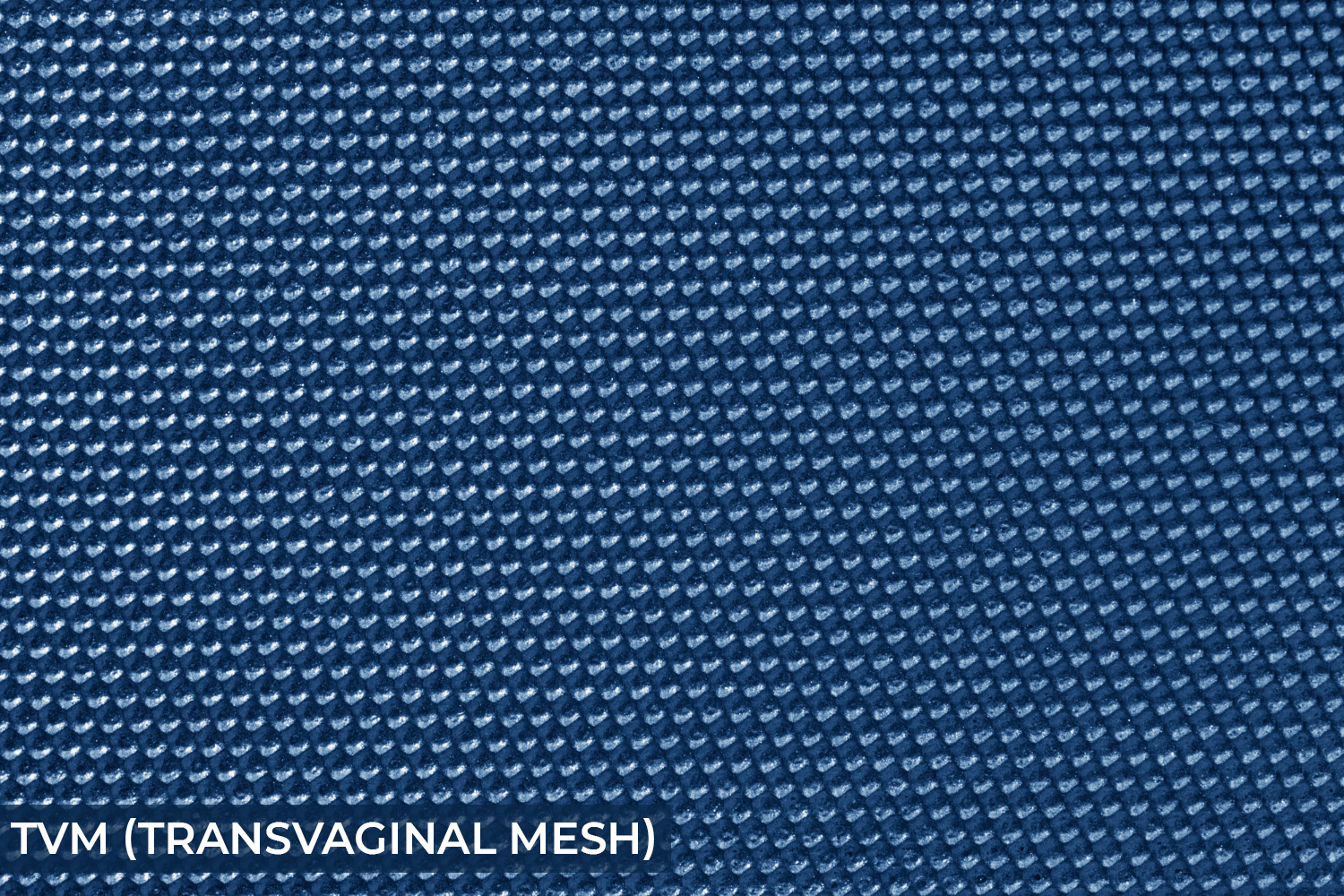Transvaginal mesh is a surgical net-like implant, manufactured by various companies such as Ethicon, C.R. Bard, American Medical Systems, Boston Scientific, Coloplast, Cook Medical, Neomedic. It is used in the form of a sling to treat stress urinary incontinence (SUI) and Pelvic organ prolapse (POP) in women since the 1990s. The insertion of this mesh or a bladder sling through the vagina is known as a transvaginal mesh. The Food and Drug Administration (FDA) approved the first surgical mesh specifically designed for SUI in 1996. Later, in 2004, the FDA approved the first surgical mesh specifically for use in POP.
Manufacturers typically make these meshes from a plastic named polypropylene, though some meshes may use animal tissue. Doctors use this type of surgical mesh to permanently fix pelvic organ prolapse (POP) and stress urinary incontinence (SUI). Doctors began using the mesh abdominally to repair POP in the 1970s. By the 1990s, gynecologists were using mesh for surgical treatment of SUI and transvaginal repair of stress urinary incontinence (SUI) and pelvic organ prolapse (POP).
Analysis of the market data by the manufacturers points out that as of 2010, a mesh was used in one out of three POP surgeries. Moreover, a transvaginal mesh was used in over 80% of the SUI surgeries. According to the FDA, surgeons performed approximately 260,000 mesh surgeries for urinary incontinence in 2010. Surgeons in the United States performed about 300,000 surgeries for POP in 2010. At the height of synthetic mesh use in 2006, one-third of all POP surgeries using mesh.
FDA began issuing warnings for complications in 2008 and 2011. The FDA focused its regulatory efforts on transvaginal mesh for POP, a procedure that the agency finds riskier. In 2016, it classified mesh for POP as a high-risk, Class III device. Then in April 2019, the Food and Drug Administration (FDA) ordered manufacturers to stop selling all remaining surgical mesh products indicated for the transvaginal repair of pelvic organ prolapse. The agency said it did not find adequate evidence to assure that the probable benefits of these devices outweighed the probable risks.
Using Transvaginal Mesh for Incontinence or Prolapse
Medical practitioners use transvaginal mesh for symptomatic pelvic organ prolapse or stress urinary incontinence. Symptomatic refers to patients experiencing pain, discomfort, or other unpleasant symptoms.
Some patients are asymptomatic, and they may not require treatment, or conservative treatments may provide relief. Surgery may be recommended by doctors when certain standard choices like pelvic floor rehabilitation, observation, pessaries fail to show expected results.
Pelvic Organ Prolapse (POP)
Pelvic organ prolapse (POP) occurs when organs sag or fall into the vaginal canal because of weak pelvic muscles. The transvaginal mesh works like a hammock beneath the organs to hold them up. Mostly, the bladder, uterus, rectum, or bowel is involved in the prolapse. The bladder is the most commonly affected organ.
Depending on the organs involved, doctors may place the section of mesh on the front, back, or top wall of the vagina. The type of mesh used also differs in shape and size. This type of surgery is usually performed transvaginally.
Stress Urinary Incontinence (SUI)
Stress urinary incontinence (SUI) takes place when the bladder leaks urine during moments of more physical activity that increase pressure on the bladder. The mesh supports the urethra when pelvic muscles weaken.
Surgical treatment of SUI with mesh also called a bladder sling or vaginal tape is the most common type of surgery used to correct the state. Surgeons use the transvaginal placement of bladder slings because it is minimally invasive and the incisions are small.
The FDA differentiates mesh into four types for gynecological use based on how the mesh reacts inside of the body. The four types include:
Non-Absorbable synthetic: Non-Absorbable synthetic meshes are made from synthetic materials, such as plastic or polyester. Most mesh devices are made of polypropylene.
Absorbable synthetic: The body absorbs absorbable synthetic mesh, and tissue grows at the implant site. This helps strengthen the ligaments in the pelvis.
Biologic: Biologic meshes are natural products derived from animal tissue that has been disinfected. These products demean over time and are usually made from cow (bovine) or pig (porcine) tissue.
Composite: Composite mesh is made from a combination of non-absorbable synthetic, absorbable synthetic, or biologic mesh.
Serious Alleged Injuries May Include:
- Abdominal And Pelvic Pain
- Multiple Surgeries To Repair Or Remove The Mesh
- Mesh Erosion
- Recurrence Of POP Or SUI
- Dyspareunia (Painful Sexual Intercourse)
FDA Safety Warnings:
Nearly 4,000 injuries were reported to the FDA between 2005 and 2010, in connection with transvaginal/pelvic mesh devices.
In 2008, the FDA issued a safety communication as it received complaints regarding the transvaginal mesh complications that patients faced during the placement of the mesh to treat SUI and POP.
In July 2011, alternative methods for POP and SUI, including conditions that may occur after childbirth, and pregnancy were recommended by the FDA when it warned patients and healthcare providers of the risks associated with the use of transvaginal mesh.
On January 5, 2016, the FDA reclassified surgical mesh for transvaginal repair of pelvic organ prolapse into class III and required submission of premarket approval (PMA) applications, the agency's most stringent device review pathway.
The FDA mandated that premarket approval applications be filed by July 5, 2018, for any surgical mesh marketed for transvaginal pelvic organ prolapse repair.
On April 16, 2019, the FDA ordered all manufacturers of surgical mesh intended for transvaginal repair of anterior compartment prolapse (cystocele) to stop selling and distributing their products immediately.
Legal Updates:
Lawsuit Status
The filing of more than 100,000 Transvaginal lawsuits, makes it one of the largest mass torts in history.
MDL Status:
There are in all 7 MDLs to handle transvaginal mesh litigations, which are being overseen by U.S. District Judge Joseph R. Goodwin in the Southern District of West Virginia. Millions have been paid in settlements, and still, thousands of claims are pending in the federal litigations.
MDL No. 2187
(In Re C. R. Bard, Inc., Pelvic Repair System Products Liability Litigation)
Formed on October 21, 2010.
There were 15,753 cases in the MDL, out of which 15,226 cases are closed.
MDL No. 2325
(In Re American Medical Systems, Inc., Pelvic Repair System Products Liability Litigation)
Formed on February 29, 2012.
There were 21,315 cases in the MDL, out of which 21,035 cases are closed.
MDL No. 2326
(In Re Boston Scientific Corp. Pelvic Repair System Products Liability Litigation)
Formed on February 29, 2012.
There were 26,030 cases in the MDL, out of which 24,976 cases are closed.
MDL No. 2327
(In Re Ethicon, Inc., Pelvic Repair System Products Liability Litigation)
Formed on February 29, 2012.
There were 40,551 cases in the MDL, out of which 38,119 cases are closed.
MDL No. 2387
(In Re Coloplast Corp. Pelvic Support Systems Products Liability Litigation)
Formed on August 20, 2012.
There were 2,717 cases in the MDL, out of which 2,676 cases are closed.
MDL No. 2440
(In Re Cook Medical, Inc., Pelvic Repair System Products Liability Litigation)
Formed on June 14, 2013.
There were 643 cases in the MDL, out of which 613 cases are closed.
MDL No. 2511
(In Re: Neomedic Pelvic Repair System Products Liability Litigation)
Formed on February 25, 2014.
There were 137cases in the MDL, out of which 135 cases are closed.
Important Verdicts & Settlements
April 24, 2019: A Philadelphia jury awarded $120 million to a woman who claimed she suffered incontinence and chronic pain due to Ethicon Inc.'s defectively designed transvaginal mesh.
October 2019: New York Attorney General Letitia James and 41 other state AGs resolved the transvaginal mesh lawsuit involving Johnson & Johnson (J&J) and their subsidiary Ethicon, Inc. for $117 million.
November 2019: J&J loses a landmark case against 1350 Australian women who suffered debilitating pain because of their defective transvaginal mesh devices.
January 2020: J&J had to pay $344 million over the lawsuits brought by California Attorney General.
March 2020: Boston Scientific agreed to pay $21.5 million to a group of 325 women who suffered side-effects of transvaginal mesh.
Evidence:
- Usage Of Device In Operative Records.
- Product Identification (Implant Sticker) In The Medical Records.
- Treatment Provided For The Injuries.
- Proof Of Injury In Medical Records.
Medical Record Review and claim validation of TVM (Transvaginal Mesh) case should take approximately 3 hours in most instances; however, this approximation may vary in cases based on the volume of records.





